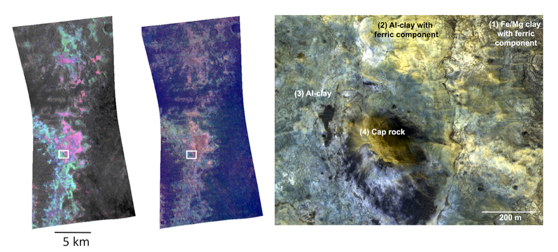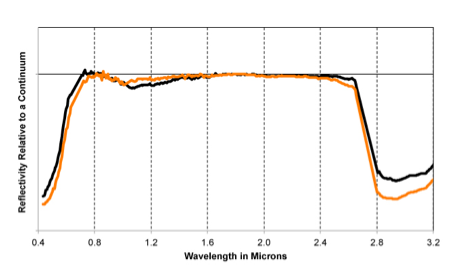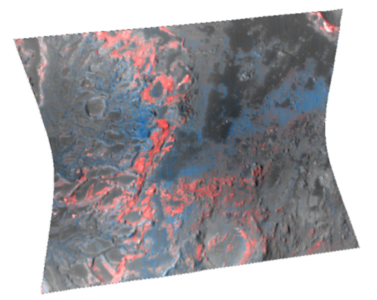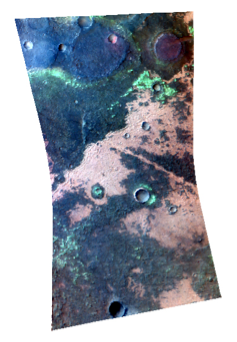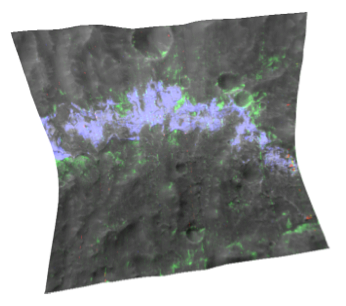CRISM's Investigations and New Discoveries (2006-present)
Theme #1: Where and when did Mars have persistently wet environments?
Science Background: "Aqueous minerals" are minerals that form in water, either by chemical alteration of pre-existing rock or by precipitation out of solution. Which minerals form depends on temperature, salinity, pH, and composition of the parent rock. Which aqueous minerals are present on Mars therefore provides important clues to understanding past environments.
There are two major characteristics about past Mars that aqueous minerals can reveal:
1) The minerals indicate where liquid water existed long enough to react chemically with rock. The types of aqueous minerals that are present provide information on environmental conditions (e.g., water chemistry, temperature, etc.) and water abundance, thereby providing clues to past Martian environments. Chloride minerals and some sulfate minerals generally indicate very saline water, and sulfates suggest acidic water. Phyllosilicates (clays and clay-like minerals) and carbonates suggest less saline water with a more neutral pH.
2) In some cases, the minerals point to where to look for fossilized evidence of ancient life, if life ever existed on Mars. If past liquid water was not too saline or acidic, if the elements needed for biology were present, and if there were sources of energy to sustain life, then the past watery environment could have been "habitable" - meaning, primitive life could have survived and reproduced in it. Minerals most suggestive of past habitable environments, and which could also fossilize a record of past life, include phyllosilicates, carbonates, and opal. One promising environment for a fossil record is at hot springs: they combine an energy source (heat) with rapidly precipitating minerals that could have fossilized past life. Hot springs are thought to have nurtured and fossilized the earliest life on Earth. They have distinct mineralogies that, if present and large enough, could be detected with CRISM. Lake environments could also have been habitable, and some are favorable for fossil preservation - particularly those that left sediments rich in carbonates or clays. Hundreds of highland craters with deposits that may have formed in lakes were recognized, even prior to CRISM, as promising locations for possible life-sustaining environments.
The Pre-CRISM view. The OMEGA spectrometer on Mars Express and the MER rovers both uncovered evidence for aqueous minerals. OMEGA revealed two distinct kinds of aqueous deposits. The first, containing sulfates such as gypsum and kieserite, is found in layered deposits of Hesperian age (Martian middle age, roughly from 3.7 to 3 billion years ago). The second, rich in several different kinds of phyllosilicates, instead occurs rocks of Noachian age (older than about 3.7 billion years). The different ages and mineral chemistries suggest an early water-rich environment in which phyllosilicates formed, followed by a dryer, more saline and acidic environment in which sulfates formed. The MER/Opportunity rover spent years exploring sedimentary rocks formed in the latter environment, full of sulfates, salts, and oxidized iron minerals.
CRISM's Science Questions and New Discoveries:
Question 1.1: Did Martian rocks ever weather to form soils like those on Earth? What do the soils tell us about past climate?
Soil forms from parent rocks through physical disintegration of rocks and by chemical alteration of the rock fragments. Physical processes that form soil include impact fracturing (much more important on Mars than Earth!), temperature cycling, freeze-thaw cycles of water in cracks, and mass wasting (sliding of loose material down slopes). Chemical processes form new minerals when the rock particles react with water, oxygen, or carbon dioxide. The types of soil minerals can tell us if the environment was cool or warm, wet or dry, or whether the water was fresh or salty. Because CRISM is able to detect many minerals that form in soil, a goal was to use the instrument to help decipher ancient Martian environments.
Question 1.2: Did Martian sedimentary rocks form in lakes or oceans, and might they preserve evidence for ancient life?
Lake and marine environments are favorable for fossil preservation, especially where the sediments they left behind are rich in carbonates or clays. Hundreds of highland craters have horizontally layered, sedimentary rocks that may have formed in lakes. CRISM has taken many targeted observations of these rocks to measure their mineralogy and how the minerals vary between layers. Variation between layers helps us to understand the sequence of events that formed the sedimentary rocks.
Question 1.3: Did Mars have hot springs, and if so where are their deposits preserved?
The identification of hot spring deposits was a priority for CRISM, because hot springs would have had energy (geothermal heat) and water, two basic requirements for life. One of the signatures of hot springs on Earth is deposits of silica, like the silicate that occurs at hot springs in Yellowstone National Park in the U.S. The Mars Exploration Rover Spirit explored a silica-rich deposit called "Home Plate" that is thought to have formed in a hot spring.
Discovery - hot spring deposits: CRISM has discovered silica-rich deposits in many locations. Some are associated with central peaks of impact craters, which are sites of heating driven by meteor impact. Silica has also been identified on the flanks of volcanic inside the caldera of the Syrtis Major shield volcano, forming light-colored mounds that look like scaled-up versions of Home Plate. Elsewhere, in the westernmost parts of Valles Marineris, near the core of the Tharsis volcanic province, there are sulfate and clay deposits suggestive of "warm" springs. Hot spring deposits are one of the most promising areas on Mars to search for evidence for past life.
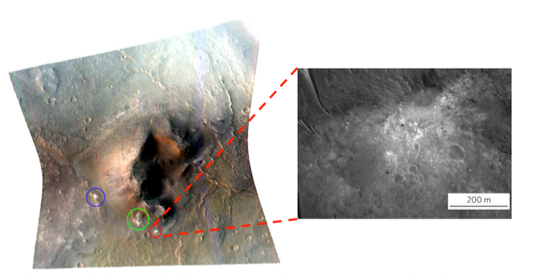
This false-color CRISM image (left) shows mounds of hydrated silica on the flank of a volcanic cone in the caldera of the Syrtis Major shield volcano. Each mound is circled in a different color; one of the mounds (circled in red) is captured in the HiRISE image at right. The mounds may have formed from hot springs that discharged onto Mars' surface and built up precipitated minerals. A hydrothermal mound like this would be a prime location in which to search for evidence of past life. The CRISM image is about 10 kilometers across.
Question 1.4: Is an ancient Martian atmosphere trapped in carbonate rocks?
One of the leading hypotheses for why ancient Mars was wetter than today is that a thick, carbon dioxide-rich atmosphere created a global greenhouse, that warmed the surface enough for liquid water to occur in large amounts. Carbon dioxide ice in today's polar caps is too limited in volume to hold that ancient atmosphere. If a thick atmosphere ever existed, it was either blown into space by solar wind or impacts, or reacted with silicate rocks to become trapped as carbonates in Mars' crust. For a couple of decades, scientists have searched but were unable to find bedrock rich in carbonate. (Earth's limestone holds over 100 atmospheres worth of carbon dioxide!)
Discovery - carbonates exist but are rare: One of the goals that drove CRISM's design was to do the best possible job of spotting carbonates. And in one of its most important discoveries, CRISM DID find carbonate bedrock! It is rare, forming scattered outcrops usually of thin layers, which is one reason why no previous instrument found carbonate bedrock. One study by CRISM scientists estimated that all of the carbonate rock holds less that the present Martian atmosphere worth of carbon dioxide. If a dense ancient atmosphere did exist, it is probably not trapped in the crust.

This false color CRISM image at left and the HiRISE image at right (at the white rectangle) show a thin carbonate layer that occurs northwest of Isidis basin. The carbonate appears pea green in the CRISM image. It is sandwiched between a layer of phyllosilicate minerals that predates Isidis and younger, erosion-resistant basaltic cap rock.

